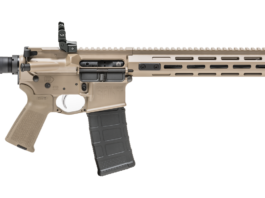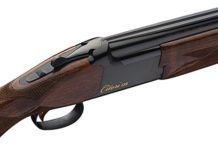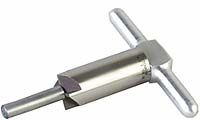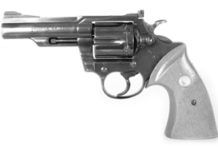Kimber Aegis Pistol Introduction: SHOT Show 2018
Gun Tests Editor Todd Woodard interviews Kimber Creative Lead Rachel Maloney about the company's new Kimber Aegis optics-ready pistol.
Gemtech Integra and Mist Suppressors: SHOT Show 2018
Gun Tests Editor Todd Woodard interviews Alexander Crown, Marketing Manager for Gemtech Suppressors, and learns about the company's suppressor-integrated uppers in 5.56 NATO and 300 Blackout and 22 LR.
SHOT Show 2018: New Shotguns
Gun Tests reporters and editors on the scene at SHOT Show 2018 in Las Vegas have been scouring the show for new rifle, pistol, shotgun, and accessory entries for our readers to consider this year. Here's a rundown on quite a few just-introduced scattergun choices for 2018, some of which we'll be looking at for further examination later this year.
Senator Wants Out-of-State CCW Holders in Jersey to Go to Jail
New Jersey has some of the most stringent CCW gun laws in the country. Its state troopers are known to pull over drivers and question them on whether they are carrying concealed firearms.
Mossberg Launches Mag-Fed 590 Pump-Action Shotgun
Magazine-fed shotguns have a couple of advantages over other styles. High-capacity shotguns like the Kel-Tec KSG and even pumpguns with extended magazine tubes tend to have balky handling. That is, they're slow to bring on target because of their mass and bulk. We have tended to prefer magazine-fed models in past tests because the weight of the shotgun, such as a mag-fed Saiga, is closer to the shooter's body and between his hands. The Mossberg 590M seems to be poised to take advantage of that design difference.
Missouri Bill Would Ban Support for Federal Gun Control Past, Present, or Future
The Tenth Amendment Center has reported that a bill introduced in the Missouri House would ban the state from enforcement of all federal gun control. Passage into law would represent a major step toward ending federal acts that infringe on the right to keep and bear arms within the state.
Giving a Firearm as a Gift? Some Reminders from Gun Tests
The first question you have to ask is whether the intended recipient can legally own the firearm where he or she lives. With more than 20,000 different gun laws on the books, even the kinds of firearms that law-abiding citizens can own vary from place to place; for example, juveniles (under age 18), generally speaking, are precluded by law from possessing a handgun.
Kimber Eclipse Target II 45 ACP, $1393
We compared two full-size 1911 handguns in the June 2013 issue to see which model offered the most bang for the buck. This Personal Defense test pitted two pistols of disparate price points to see if the less expensive model offered enough to consider it versus a fully equipped modern handgun. Tested were the Rock Island Armory Standard GI No. 51421 45 ACP, $410; and the Kimber Eclipse Target II 45 ACP, $1393. Here's an excerpt of that test.
Pillar Bedding: How to Spot Botched Jobs on Rifles
In my years working on guns, I have seen a large number of totally botched bedding jobs. In fact, you would be shocked to see what people do to their guns' bedding to increase the accuracy of a rifle. But do you know how to spot the most common mistakes in bedding, thereby giving you a leg up in improving a gun's accuracy, or avoiding it altogether? Following are the most common problems shooters should watch for:
Colt Trooper Mark III .357 Magnum
The Colt Trooper was made from 1953 to 1969. The Trooper Mark III superceded the Trooper and had a redesigned lock mechanism. It was manufactured from 1969 to 1983 in blue and nickel finish with 4-, 6-, and 8-inch barrel lengths. An owner's manual can be obtained by calling Colt at (800) 962-2658. The Trooper III in our test was made in 1974.
The Colt Trooper Mark III is for all practical purposes the working man's Python. Sound good? It features a serrated front sight pinned in place. The rear sight is fully adjustable, and it should be more durable than similar designs since the rear notch moves back and forth inside a protective frame. While adjustment for elevation is clockwise for down and counter-clockwise for up, the windage adjustment is reversed. Turn it to the right if you want the point of impact to move left, and turn left to bring the POI to the right.
Another feature is the direction in which the cylinder rotates. While other revolvers move counterclockwise, expecting a Colt to go bang requires the first round to be in the 11 o'clock position prior to cycling. Also, to release the cylinder one pulls rather than pushes on the latch.
Repairing Crosman Air Guns
The quantity of air-gun parts per gun is about the same or less than the number of parts in cartridge firearms. In fact, many air-gun parts look and function like their counterparts in firearms we're already familiar with. Here's an inside look at the Crosman 760 air rifle.
In Texas, Better Protection for Class 3 Devices Is Coming
In about a month, gun owners in Texas and visitors to the state will feel the positive effects ofSB 473, a bill which Texas Gov. Gregg Abbott signed into law that extends protections for Class 3 devices, such as short-barreled rifles (SBRs), suppressors, and "any other weapons," as defined by the National Firearms Act. SB 473 will take effect on Sept. 1, 2015.



































